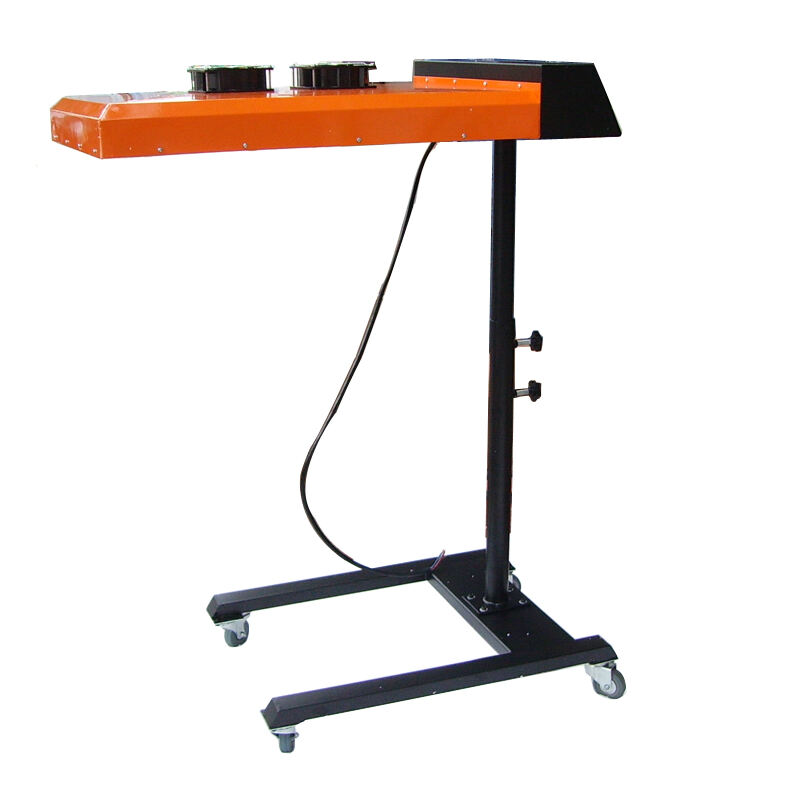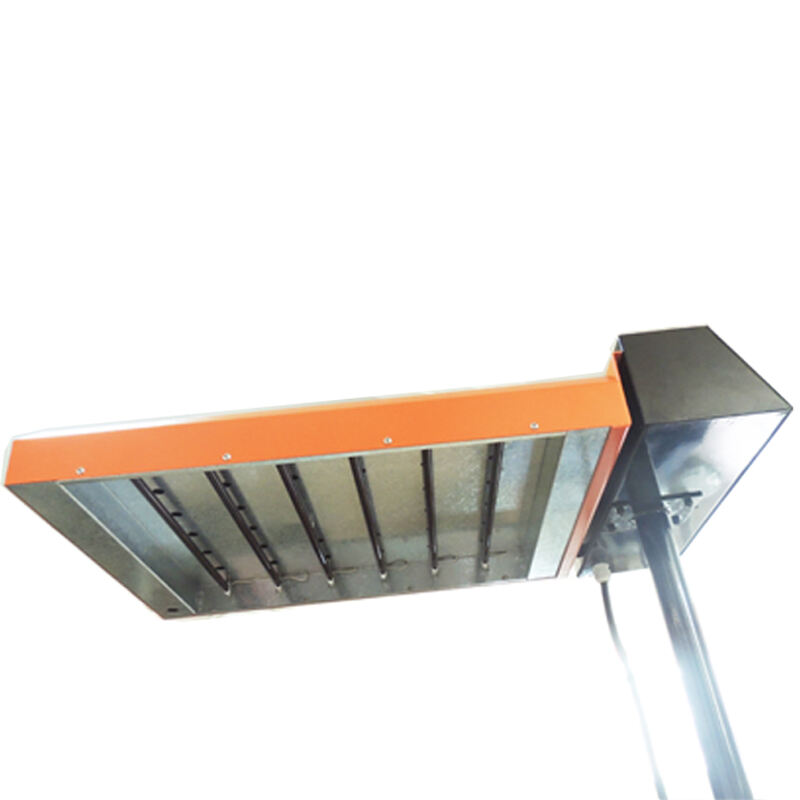Kujdes Esencial për Tharjen e Shkurtër për Printim me ekran Larg
Në botën e shtypit me ekran, një largues prejor shërben si kurriz i efikasitetit të prodhimit dhe cilësisë së shtypjes. Këto njësi ngrohëse të fuqishme kurajojnë bojën midis aplikimeve të ngjyrave, duke i bërë ato të pamjaftueshme për shtypësit profesionistë me ekran. Megjithatë, si çdo pjesë e rëndësishme e pajisjeve, tharësit me çkarkim kërkojnë mirëmbajtje të qëndrueshme dhe të hollësishme për të funksionuar në nivelin më të lartë dhe për të siguruar gjatësi jetë. Njohja e teknikave të duhura të mirëmbajtjes jo vetëm që zgjaton jetëgjatësinë e pajisjeve, por gjithashtu ruan cilësinë e shtypjes dhe efikasitetin e prodhimit.
Shumë profesionistë të shtypit me ekran nënvlerësojnë ndikimin e mirëmbajtjes së rregullt të tharësit të shpejtë në fitimin e tyre neto. Një njësi e mirëmbajtur funksionon më efikasisht, konsumon më pak energji dhe prodhon rezultate më të qëndrueshme. Le të eksplorojmë strategji të hollësishme mirëmbajtjeje që do të mbajnë tharësin tuaj të shpejtë të funksionojë optimalisht vit pas viti.
Kuptimi i Përbërësve të Tharësit të Shpejtë dhe Kujdesi për Ta
Mirëmbajtja e Elementit të Ngrohjes
Elementi i ngrohjes është zemra e tharësit tuaj të shkurtër, i përgjegjshëm për prodhimin e nxehtësisë së nevojshme për fiksimin e bojës. Kontrolli i rregullt i elementit të ngrohjes siguron performancë optimale dhe parandalon dështimet e papritura. Kërkoni shenja të deformimit, ndryshimi i ngjyrës ose dëmtimi që mund të ndikojnë në shpërndarjen e nxehtësisë. Pastrojeni me kujdes elementin me solucione të përshtatshme pastruese, duke siguruar që të mos mbetet asnjë mbetje që mund të ndikojë në performancë ose të krijojë erë të padëshirueshme gjatë funksionimit.
Mendoni të vini në praktikë një skedar mujor pastrimi për elementin tuaj të ngrohjes. Kjo praktikë ndihmon në ruajtjen e daljes së nxehtësisë në mënyrë të vazhdueshme dhe parandalon grumbullimin e grimcave të bojës apo copave të tjera që mund të komprometojnë performancën. Mbani mend që gjithmonë lejoni që pajisja të ftohet plotësisht para se të filloni çdo procedurë pastrimi apo mirëmbajtjeje.
Kujdesi i Sistemit të Kontrollit të Temperaturës
Kontrolli i saktë i temperaturës është i thelbëshëm për të arritur rezultate të qëndrueshme në procesin e tharjes. Kalibrimi i rregullt i sistemit të kontrollit të temperaturës së tharësit me çlirime të shpejta siguron nivеле të sakta ngrohjeje dhe parandalon problemet e tharjes së pamjaftueshme ose të tepruar. Kontrolloni saktësinë e leximeve të temperaturës duke përdorur një termometër infrigjerm, dhe rregulloni cilësimet sipas nevojës. Dokumentoni çdo variacion për të ndjekur degradimin e mundshëm të sistemit me kalimin e kohës.
Tharësit modernë me çlirime të shpejta shpesh kanë kontrolle digjitale të temperaturës që kërkojnë përditësime periodike të softuerit ose rikalibrime. Mbani ritmin me rekomandimet e prodhuesit lidhur me mirëmbajtjen e sistemit të kontrollit për të ruajtur funksionimin optimal dhe saktësinë.

Praktikat e mira operative ditore
Procedurat e duhura për nisje dhe fikje
Zbatimi i procedurave të sakta të nisjes dhe ndalimit zgjat në mënyrë të konsiderueshme jetëgjatësinë e tharësit të flasheve. Filloni çdo ditë duke kontrolluar pajisjen për dëmtime të dukshme ose komponente të lirë. Lëreni tharësin e flasheve të ngrohet ngadalë, duke shmangur ndryshimet e papritura të temperaturës që mund të shtresojnë elementët ngrohës. Në fund të çdo turnu, ndiqni një proces sistematik ndalimi që përfshin periudha të duhura ftohjeje.
Zhvilloni një listë kontrolli që operatorët të ndjekin gjatë nisjes dhe ndalimit. Kjo garanton konzistencë në procedura dhe ndihmon në identifikimin e problemeve potenciale para se të bëhen probleme serioze. Trajnioni të gjithë punonjësit mbi këto procedura për të ruajtur integritetin e pajisjeve gjatë turneve.
Monitorimi i Metrikave të Performancës
Mbani regjistrime të hollësishme të metrikave të performancës së tharësit tuaj me çelës, përfshirë konzistencën e temperaturës, kohët e ngrohjes dhe konsumin e energjisë. Këto të dhëna ndihmojnë në identifikimin e problemeve potenciale para se të ndikojnë në prodhimin. Gjurmohini kohët e fiksimit dhe cilësimet e temperaturës për nënstratumet dhe llojet e ndryshme të bojërave për të optimizuar efikasitetin e prodhimit.
Monitorimi i rregullt lejon planifikimin paraprak të mirëmbajtjes dhe ndihmon në parandalimin e pushimeve të papritura. Vendosni metrika bazike të performancës dhe hetoni menjëherë devijimet e mëdha.
Shkallë mbajtje përkufizuese
Pikat e Inspektimit Javor
Zhvilloni një listë kontrolli të hollësishme javore për mirëmbajtje që përfshin kontrollin e lidhjeve elektrike, kontrollin për pajisje të lira dhe vlerësimin e gjendjes së veçorive të sigurisë. Fokusohuni veçanërisht tek zonat ku zakonisht grumbullohen pluhuri dhe mbeturina. Pastrojeni portat e ventilimit dhe sigurohuni që rrjedha e ajrit rreth pajisjes të jetë e duhura.
Dokumentoni të gjitha inspektimet dhe veprimtaritë e mirëmbajtjes në një regjistër të dedikuar. Kjo dokumentim ndihmon në gjurmimin e historisë së pajisjeve dhe identifikimin e modeleve që mund të tregojnë probleme të nxitura. Zgjidhni menjëherë problemet e vogla për t'i parandaluar ato të shndërrohen në riparime të mëdha.
Protokolli i Pastrimit të Thellë Mujor
Mirëmbajtja mujore duhet të përfshijë një pastrim të hollësishëm të të gjithë komponentëve të tharësit me flashe, përfshirë edhe zonat që nuk janë lehtësisht të arritshme gjatë pastrimit ditie. Hiqni dhe pastrojeni panelet reflektuese nëse janë të pranishme, kontrolloni dhe ngjisni tërë pajisjet e montimit, dhe inspektoni lidhjet elektrike për shenja të konsumit ose dëmtimit.
Përdorni produkte dhe teknika pastrimi të rekomanduara nga prodhuesi për të shmangur dëmtimin e komponentëve të ndjeshëm. Planifikoni këto seanca më të thella mirëmbajtjeje gjatë kohës së planifikuar pushimi për të minimizuar ndikimin në oraret e prodhimit.
Zgjidhja e problemeve të zakonshme
Zgjidhje për Fluktuacionet e Temperaturës
Kur hasni me inkonsistencë të temperaturës, kontrolloni sistematikisht elementët e nxehtësisë, sensorët e temperaturës dhe sistemet e kontrollit. Njohja e shkakëve të zakonshëm të fluktuacioneve të temperaturës ndihmon në identifikimin dhe zgjidhjen e shpejtë të problemeve. Mbajeni gati pjesë zëvendësuese për komponentët kritikë për të minimizuar pushimet kur nevojiten riparime.
Dokumentoni hapat e diagnostifikimit dhe zgjidhjet për problemet e zakonshme. Kjo bazë njohurish bëhet e pavlerë për trajnimin e stafit të ri dhe për ruajtjen e një mirëmbajtjeje të konsekuentë të pajisjeve në gjithë operacionin tuaj.
Teknika për Optimizimin e Performancës
Testimi i rregullt i performancës ndihmon në ruajtjen e funksionimit optimal të tharësit të shpërthimit. Kryeni testime periodike të shpërndarjes së nxehtësisë duke përdorur shiritra temperaturë ose imazheri termalë për të siguruar nxehtësi të barabartë mbi sipërfaqen e ngurtësimit. Rregullojini lartësinë dhe pozicionin për të optimizuar efikasitetin e ngurtësimit, ndërkohë që parandaloni djegien ose ngurtësimin e pashërbër.
Konsideroni faktorët ambientalë që mund të ndikojnë në performancë, si temperatura ambientale dhe niveli i lagështisë. Modifikoni cilësimet përkatëse për të ruajtur rezultate të qëndrueshme të tharjes gjatë ndryshimeve stinore.
Pyetje të Bëra Shpesh
Sa shpesh duhet ta zëvendësoj elementët e ngrohjes në tharësin tim të shpejtë?
Zëvendësimi i elementit ngrohës zakonisht varet nga modelet e përdorimit dhe cilësia e mirëmbajtjes. Me kujdesin e duhur, elementët mund të zgjasin 2-3 vjet ose më shumë. Megjithatë, monitoroni rregullisht performancën dhe zëvendësoni elementët nëse vini re ngrohje të pabarabartë, ulje të efikasitetit ose dëmtime të dukshme.
Cilat janë shenjat që tharësi im i shpejtë ka nevojë për mirëmbajtje urgjente?
Treguesit kryesorë përfshijnë tharje të papajtueshme, lëkundje të papritura të temperaturës, zhurma të pazakonta gjatë funksionimit, dëmtime të dukshme në pjesët përbërëse ose konsum të rritur energjie. Trajtoni këto shenja menjëherë për të parandaluar probleme më serioze dhe vonesa në prodhim.
A mund ta pastroj tharësin tim të shpejtë kur është ende i ngrohtë?
Mos u përpjekni kurrë të pastrosh një tharës të shpejtë kur është i nxehtë ose i ngrohtë. Gjithmonë lejoni që pajisja të ftohet plotësisht para se të kryeni çdo procedurë mirëmbajtjeje ose pastrimi. Kjo garanton sigurinë dhe parandalon dëmtimin e pajisjes si dhe të materialeve për pastrim.
Çfarë lloj produkteve të pastërimit janë të sigurta për t'u përdorur në një tharës të shpejtë?
Përdorni vetëm produkte të rekomanduara nga prodhuesi ose agjente të butë, jo-abrazivë. Shmangni substancat kimike të forta që mund të dëmtojnë pjesët elektrike ose sipërfaqet reflektuese. Gjithmonë testoni produktet e pastërimit në një zonë të vogël në fillim dhe sigurohuni që ka ventilim të duhur gjatë procedurave të pastrimit.
Përmbajtja
- Kujdes Esencial për Tharjen e Shkurtër për Printim me ekran Larg
- Kuptimi i Përbërësve të Tharësit të Shpejtë dhe Kujdesi për Ta
- Praktikat e mira operative ditore
- Shkallë mbajtje përkufizuese
- Zgjidhja e problemeve të zakonshme
-
Pyetje të Bëra Shpesh
- Sa shpesh duhet ta zëvendësoj elementët e ngrohjes në tharësin tim të shpejtë?
- Cilat janë shenjat që tharësi im i shpejtë ka nevojë për mirëmbajtje urgjente?
- A mund ta pastroj tharësin tim të shpejtë kur është ende i ngrohtë?
- Çfarë lloj produkteve të pastërimit janë të sigurta për t'u përdorur në një tharës të shpejtë?

